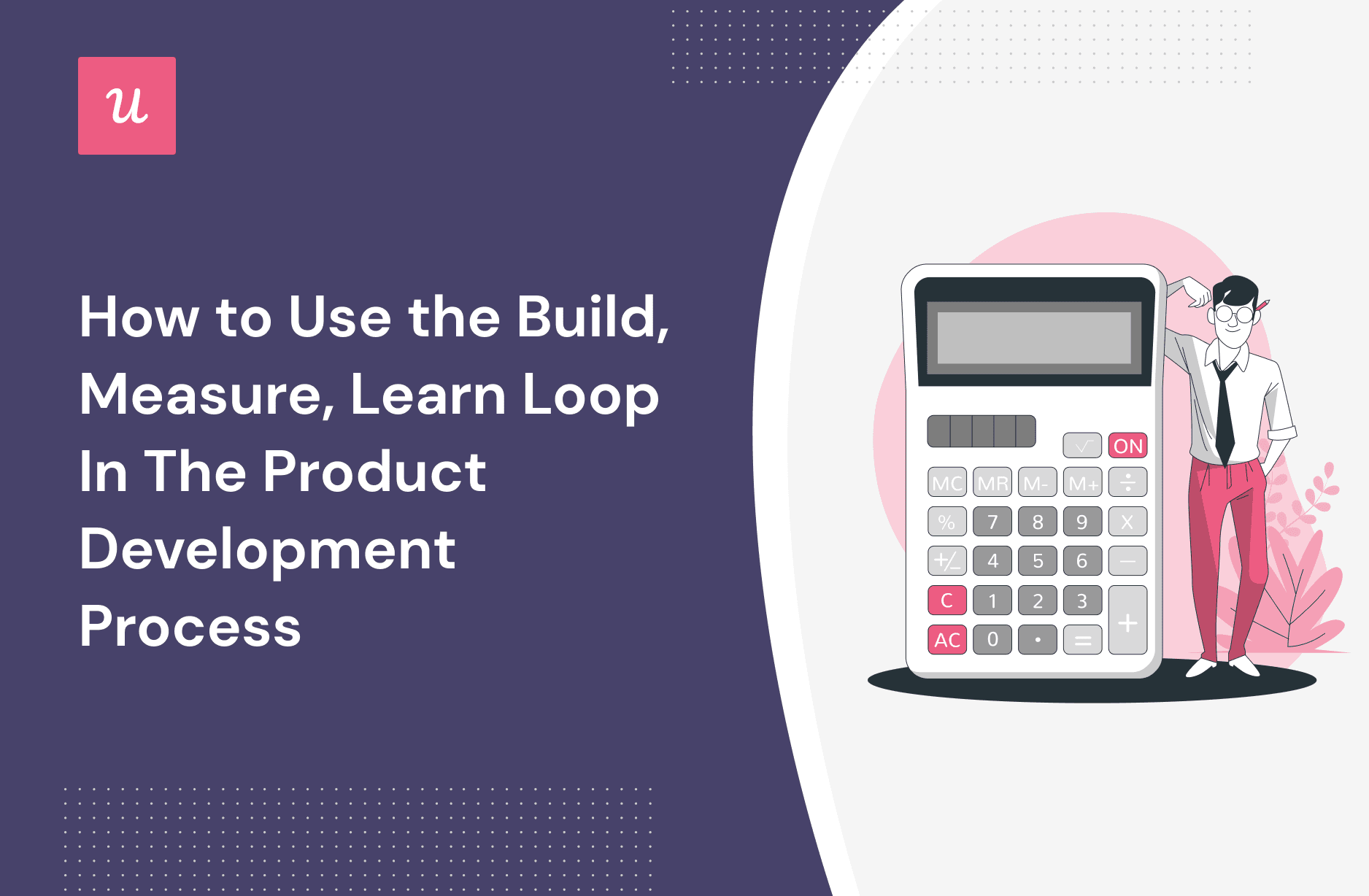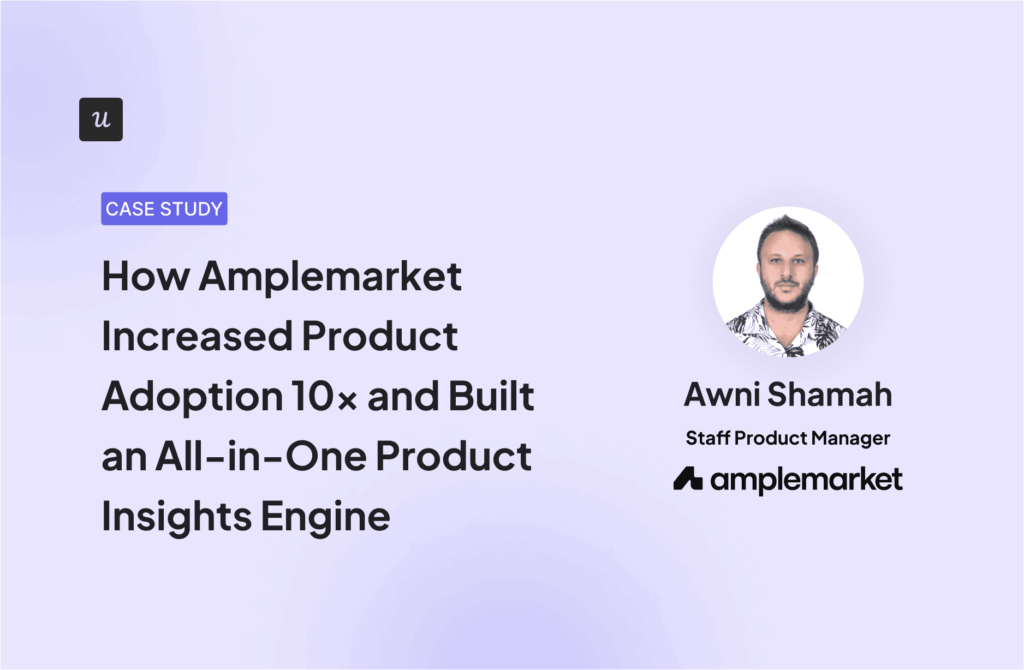
How to Use the Build, Measure, Learn Loop In The Product Development Process
The build-measure-learn process is a fundamental part of the lean startup methodology introduced by Eric Ries in his book “The Lean Startup.”
Over time, companies across different industries have used it as a valuable tool for building successful products. Read on to see how to apply this framework at every stage of your product development cycle and drive product growth.
Get The Insights!
The fastest way to learn about Product Growth, Management & Trends.
What is the build-measure-learn cycle?
The build-measure-learn cycle is an iterative process used in product development. It involves creating a product, measuring its performance, and using the insights gained to make informed adjustments, ultimately leading to continuous improvement.
The process allows businesses to validate their assumptions, identify what works and improve their products over time.

The benefits of using the build-measure-learn method from the lean startup methodology
The build-measure-learn loop helps you speed up business processes and make much progress in less time.
Below are some of the upsides of this loop:
- Faster time to market: The framework accelerates product development by focusing on creating minimum viable products (MVP) quickly. By releasing an MVP with essential features, you can bring your product to market faster than traditional development approaches.
- Reduced risks: The methodology’s iterative nature helps mitigate risks associated with building products that may not resonate with users. By developing an MVP and measuring user reactions, you can identify potential pitfalls and pivot or make adjustments before significant resources are committed.
- Cost-effective: The build-measure-learn approach is cost-effective because it promotes a “fail fast, fail cheap” mindset. This prevents wasting time and money on features or ideas that may not align with customer needs.
How to effectively implement the build-measure-learn approach
This section shows you steps to take for each of the three phases in the build-measure-learn loop.
Build phase steps
Here, the startup creates a business plan that outlines its unique value proposition and customer base.
This phase aims to swiftly bring a functional product to life, focusing on speed rather than perfection. By building the MVP, you create something tangible that can be tested and validated by real users.
Let’s discuss this in more detail.
Conduct market research and define your target audience
An in-depth market and competitor research lets you understand if there is really a demand for your service.
Then, you use the data from your research to create user and buyer personas for your product. In your template, you should outline user motivations, pain points, and challenges, mapping how your product can solve them.

Create a minimum viable product for your business idea, highlighting the core components of your app
An MVP is the smallest and simplest possible product version that still allows you to test your hypothesis.
It’s central to the build-measure-learn framework.
Note that you’re not fleshing out an entire product. There are different types of MVPs—it can be a landing page, a single feature app, etc.
Once your MVP is ready, launch it and test it with a small group of users.
Let’s consider an MVP example from a popular SaaS company.
Buffer’s MVP was a simple landing page that explained what Buffer was, how the platform would work and showcased the pricing plans. More importantly, they used the landing page to collect email addresses and followed up on interested visitors.

Measure phase steps
This phase comes after launching your MVP.
Your goal here is to gain insights into how users use the MVP, how effective it is at addressing the identified problem, and whether it meets user needs.
Data collected during this phase informs your understanding of the product’s impact.
Choose the right metrics to measure the success of your launch
It’s essential to choose actionable metrics instead of vanity metrics—surface-level data that doesn’t translate into business results.
You can’t go wrong tracking the following:
- Customer acquisition cost: CAC is the cost incurred to acquire a new customer. By monitoring CAC, you can adjust your marketing channels, campaigns, and targeting to optimize acquisition costs and maximize returns on investment.
- Activation rate: this measures the percentage of users who successfully complete the initial steps required to experience value from your product after sign-up. A high activation rate indicates that users are finding value in your product early on. A low rate may signify usability issues or a lack of clear onboarding.
- Product-market fit: this metric assesses how well your product meets the needs and preferences of your target market. Achieving product-market fit is crucial for sustained success. It indicates that your product solves a real problem and resonates with your intended audience.
- Net Promoter Score: NPS measures customer gauges user satisfaction by asking customers how likely they are to recommend your brand to others. it can be used to measure the overall health of the company as well as how specific touchpoints affect loyalty.
- Customer satisfaction score: CSAT gauges user satisfaction by asking customers to rate their experience with your product or service on a scale. It focuses on specific interactions or features. Analyze CSAT scores for specific interactions or features to pinpoint areas that need enhancement.
Perform usability tests to validate your hypothesis
Invite users to participate in usability tests to validate your hypothesis and find potential user experience issues.
Here are your usability testing options for the build-measure-learn loop:
- 5-Second test: Show participants a design or interface for just five seconds, and ask them to recall what they remember.
- First-click test: This test aims to see if participants can identify the happy path on their own. Conduct your first-click test by showing participants a screenshot of your product or website and asking them to click on the feature that they think is the most important.
- Guerilla testing: This involves going to public places—such as a restaurant—and asking random people for feedback on your prototype.
- Lab usability testing: This is a more intense testing method. Here, you segment users and have them use your product or prototype in a controlled lab setting while researchers observe and collect data.
- Unmoderated remote usability testing: Participants perform tasks on your product remotely, without direct interaction with a moderator. They record their actions and feedback.
Collect customer feedback with in-app surveys and interviews
Customer feedback helps you understand user expectations, find improvement opportunities and implement them to better meet user needs.
In-app surveys are a fast and effective way of collecting targeted feedback at scale. Thanks to modern tools, you can create and trigger completely code-free.
It’s best to combine surveys with user interviews to get more in-depth insights into the user experience.

Learn phase steps
In the Learn phase, you analyze the data gathered from the measure phase to draw meaningful conclusions. Based on these insights, you make informed decisions about whether to refine, iterate, or pivot the product.
How to go about it:
Analyze the collected data for validated learning
Analyze the collected quantitative and qualitative data to identify patterns and draw insights from them.
Depending on the approach you used to collect data, this can look like:
- Segmenting user personas and looking at the in-app behavior of each segment.
- Tagging NPS responses to understand the main reasons behind positive and negative scores.
- Reviewing qualitative data from feedback surveys and interviews to find recurring themes, sentiments, and specific user pain points.

Don’t forget to compare the data analyzed against the hypotheses you formulated during the build phase. Determine whether the data supports or refutes your initial assumptions.
Look for evidence of success, areas for improvement, or unexpected insights from the build-measure-learn steps you implemented.
Share your findings and insights with internal stakeholders
Share the data company-wide to get everyone on the same page and promote cross-team collaboration.
Cross-functional discussions based on data can lead to innovative solutions and strategies that might not have been apparent without a comprehensive understanding of the user experience.
Conclusion
There’s so much unpredictability when it comes to product development: you need to build what customers will actually love and pay for, and you often have limited resources for testing.
The build-measure-learn methodology comes to the rescue. It empowers you to transform hypotheses into actionable insights, paving the way for innovation and continuous improvement.
For the loop to work effectively, you need a tool that can help you collect and make sense of user data. This is where Userpilot comes in. Get a Userpilot demo now and learn how it can help you manage customer feedback.





